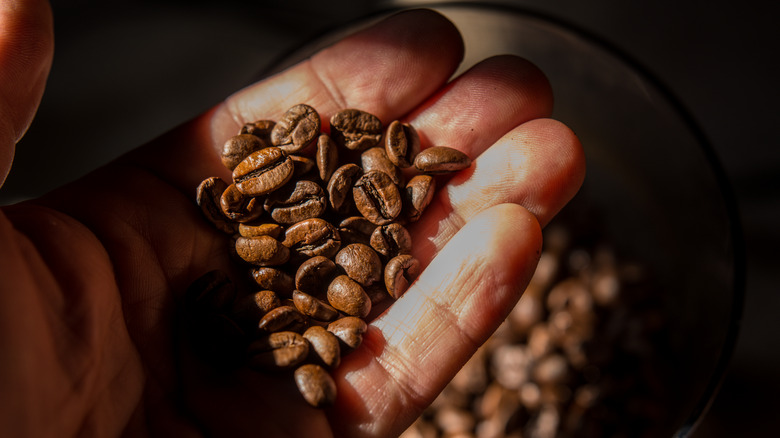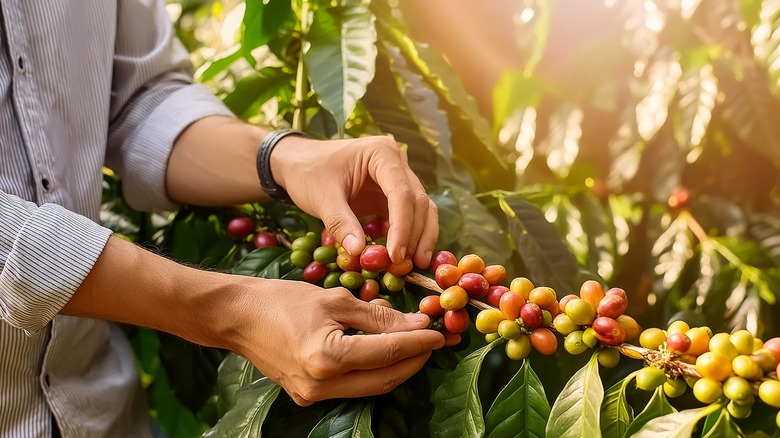How To Choose Your Coffee Beans Based On Their Altitude Level
We tend to think of our morning coffee not as a plant or a crop but as a shelf-stable good and, for true coffee lovers, an essential part of our day. But as a crop, coffee is subject to the whims of Mother Nature as it grows. Crucially, the altitude at which the coffee is grown makes a significant difference to the final taste and flavor of the bean and, therefore, your morning cup, iced coffee, or its stronger cousin, cold brew.
There's a reason you don't just see coffee plants growing in everyone's backyard garden (trust and believe, if this was an option, we'd be doing it). It's because coffee demands highly particular growing conditions, and plants specifically thrive in subtropical climates, with many of the best hailing from the "bean belt" region in South American countries like Brazil, Ethiopia, Colombia, and Hawaii — all of which enjoy similar temperature and altitude ranches. As anyone who's traveled much knows, higher altitude regions have colder temperatures, with larger temperature fluctuations over 24 hours. According to Mathew Woodburn-Simmonds, ex-barista and coffee expert behind the Home Coffee Expert site, the cold temps at high altitude slow the ripening process — a very good thing for flavorful, complex coffee beans. The end result? A more interesting cup with an unparalleled depth of flavor.
Slow grown is best, if you're after a complex, rich cup of joe
Mathew Woodburn-Simmonds explains further what that sweet, slow ripening time means. Good things come to those who wait, as is certainly the case for the most flavorful, acidic coffee beans; high-altitude beans produce a rich, fruity, spicy cup.
But what altitude is best? According to Woodburn-Simmonds, "Ethiopian coffee is generally grown at very high altitudes, often over 6,000 feet above sea level, and has this immense perfume and delicate aromatics." The benefits to aromatics and flavors extend to all beans grown above 4,000 feet, which is considered high altitude. A good middle ground is a bean grown within the 2,500 to 4,000 foot range, which tends to yield a bean with more sweetness and a brighter flavor. Lower-grown beans will tend to be more one-note and subtle.
As coffee cherries grow, they develop and ripen from a bright green to a darker red hue. They are picked from the plant and separated from the surrounding skin and pulp. What's left is the bean, which gets dried, roasted, and sold to coffee lovers. Eagle-eyed coffee connoisseurs can tell at what altitude the bean was grown just from a quick visual inspection of green, unroasted coffee – the beans' shape, fissure line, and color will all indicate its growing conditions. In most cases though, you're likely buying pre-roasted beans, so just ask the barista or roaster to tell you the altitude of the bag you're considering.
Coffee altitude is far from an exact science
It's important to note that, like all art — which a great cup of coffee is — there's no exact science to deciphering the affects of altitude. You can't definitively pin down an altitude to guarantee the best brew. These things are a bit fluid and depend on many factors like the types of beans and the coffee farm in question, as Matthew Woodburn-Simmons reminds us.
Case in point, although high altitude is typically best for developing bean flavor, there are exceptional coffees produced at low altitudes due to shady growing conditions or farms at certain latitude points. Woodburn-Simmonds applauds anyone paying attention to the altitude at all — noting it's a good sign that you're on the path of more robust, higher quality coffee than perhaps less sophisticated sippers who grab any old bag and call it a day.
These caveats aside, if you're looking for the highest-quality, most nuanced cup of joe, go for beans grown at a higher altitude. Your prep methods, flavor additions and coffee creamers, and factors like the beans' packaging certainly matter, but they only go so far. It all starts with the origin of the bean you choose.


